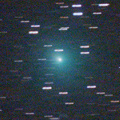
|
Now it is very bright as 3.6 mag (Dec. 16, Marco Goiato). Visible with naked eyes. It is approaching to Earth down to 0.08 a.u., and it looks so large as 3 times of Moon. In the Northern Hemisphere, it stays observable in excellent condition. In the Southern Hemisphere, it will be getting lower rapidly after this, and it will be unobservable in late December.
Date(TT) R.A. (2000) Decl. Delta r Elong. m1 Best Time(A, h)
Dec. 15 3 47.37 16 29.0 0.078 1.056 155 3.2 22:16 (180, 36)
Dec. 22 4 59.09 40 49.9 0.084 1.063 158 3.3 23:03 (180, 12)
|
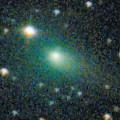
|
Now it is bright as 9.5 mag (Dec. 14, Marco Goiato). It stays 9-10 mag until January. In the Northern Hemisphere, it stays observable in good condition for a long time until it fades out. It locates low in the Southern Hemispehre.
Date(TT) R.A. (2000) Decl. Delta r Elong. m1 Best Time(A, h)
Dec. 15 8 26.18 34 14.6 0.766 1.645 139 9.3 2:53 (180, 21)
Dec. 22 8 31.50 37 3.9 0.768 1.670 144 9.5 2:31 (180, 18)
|
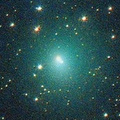
|
Now it is very bright as 9.0 mag (Dec. 14, Juan Jose Gonzalez). It is observable in excellent condition in the Northern Hemisphere. It stays low in the Southern Hemisphere.
Date(TT) R.A. (2000) Decl. Delta r Elong. m1 Best Time(A, h)
Dec. 15 2 15.84 32 22.7 0.597 1.478 136 10.5 20:56 (177, 23)
Dec. 22 2 33.03 31 18.3 0.648 1.507 133 10.9 21:01 (173, 23)
|
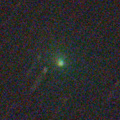
|
Now it is 11.3 mag (Nov. 30, Seiichi Yoshida). It stays at 11 mag until February. In the Northern Hemisphere, it stays observable for a long time until it fades out. But it stays extremely low. It will never be observable again in the Southern Hemisphere.
Date(TT) R.A. (2000) Decl. Delta r Elong. m1 Best Time(A, h)
Dec. 15 18 5.91 13 10.3 2.392 1.719 37 10.8 20:56 ( 80,-37)
Dec. 22 18 25.57 15 24.4 2.374 1.731 39 10.8 21:01 ( 80,-41)
|

|
It brightened up to 7.7 mag in June (June 19, Juan Jose Gonzalez). Now it is fading. But it is still bright as 10.6 mag (Dec. 7, Chris Wyatt). In the Southern Hemisphere, it stays observable in good condition for a long time until the comet will fade out. In the Northern Hemisphere, it is not observable for a long time until autumn in 2019 when the comet fades out down to 16 mag.
Date(TT) R.A. (2000) Decl. Delta r Elong. m1 Best Time(A, h)
Dec. 15 16 38.97 -81 50.5 3.011 2.640 58 11.2 2:53 (352, 30)
Dec. 22 17 37.39 -84 9.7 3.022 2.683 60 11.3 2:55 (355, 31)
|
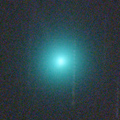
|
New bright comet discovered by three amateur comet hunters. It brightened rapidly from 10 mag up to 8 mag just after the discovery. But after that, the brightness evolution became slow. Now it is 9.5 mag (Dec. 9, Alan Hale). In the Northern Hemisphere, it will never be observable again after this. In the Southern Hemisphere, it will appear in the morning sky in February. But it may be fainter than 18 mag at that time.
Date(TT) R.A. (2000) Decl. Delta r Elong. m1 Best Time(A, h)
Dec. 15 19 1.70 -14 33.3 1.200 0.496 23 11.4 20:56 ( 65, -9)
Dec. 22 19 20.82 -18 14.6 1.450 0.621 19 13.0 21:01 ( 60, -9)
|

|
Now it is 11.5 mag (Dec. 14, Juan Jose Gonzalez). It stays 12 mag for a long time until spring.
Date(TT) R.A. (2000) Decl. Delta r Elong. m1 Best Time(A, h)
Dec. 15 7 58.37 -13 22.2 2.383 3.089 128 12.2 2:26 (180, 68)
Dec. 22 7 43.60 -15 36.2 2.367 3.125 133 12.3 1:44 (180, 71)
|

|
Now it is 12.8 mag (Nov. 14, Sandor Szabo). It will be fading slowly after this. It is observable in good condition in the Northern Hemisphere. In the Southern Hemisphere, it is not observable until summer in 2019.
Date(TT) R.A. (2000) Decl. Delta r Elong. m1 Best Time(A, h)
Dec. 15 14 59.81 40 35.5 3.619 3.454 72 12.8 2:53 (238,-28)
Dec. 22 15 10.32 40 30.9 3.622 3.500 75 12.8 2:55 (236,-24)
|

|
Now it is 13.3 mag (Dec. 5, Sandor Szabo). It stays at 12-13 mag for a long time until autumn in 2019.
Date(TT) R.A. (2000) Decl. Delta r Elong. m1 Best Time(A, h)
Dec. 15 22 24.17 -6 45.2 2.280 2.198 72 13.0 20:56 (101, 27)
Dec. 22 22 35.57 -5 58.7 2.336 2.176 68 13.0 21:01 ( 99, 22)
|

|
It brightened up to 6.8 mag in September (Sept. 17, Seiichi Yoshida). Now it is fading rapidly. It has already faded down to 13.8 mag (Dec. 15, R. Ramlow). It is observable in excellent condition in the Southern Hemisphere. It locates low after this in the Northern Hemisphere.
Date(TT) R.A. (2000) Decl. Delta r Elong. m1 Best Time(A, h)
Dec. 15 6 47.61 -39 36.6 0.954 1.630 114 13.5 1:15 ( 0, 85)
Dec. 22 6 37.37 -39 1.5 1.005 1.695 116 14.0 0:37 ( 0, 86)
|

|
Now it is bright as 12.9 mag (Dec. 5, Sandor Szabo).
Date(TT) R.A. (2000) Decl. Delta r Elong. m1 Best Time(A, h)
Dec. 15 22 51.59 -0 36.6 5.833 5.768 81 13.5 20:56 (111, 28)
Dec. 22 22 54.40 -0 22.7 5.943 5.768 75 13.6 21:01 (106, 22)
|

|
Now it is 14.0 mag (Nov. 26, Chris Wyatt). It will brighten up to 10-11 mag in autumn in 2019. It stays observable in good condition for a while in the Southern Hemisphere. In the Northern Hemisphere, it stays extremely low for a long time.
Date(TT) R.A. (2000) Decl. Delta r Elong. m1 Best Time(A, h)
Dec. 15 1 11.25 -38 30.3 4.232 4.409 93 13.6 20:56 ( 73, 74)
Dec. 22 1 7.47 -36 44.7 4.275 4.366 88 13.6 21:01 ( 78, 66)
|
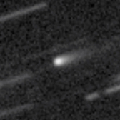
|
Now it is 13.7 mag (Dec. 10, Toshihiko Ikemura, Hirohisa Sato). It is observable at 14 mag in excellent condition until March.
Date(TT) R.A. (2000) Decl. Delta r Elong. m1 Best Time(A, h)
Dec. 15 10 52.59 3 40.7 1.137 1.623 99 14.1 2:53 (229, 38)
Dec. 22 11 4.77 1 56.0 1.089 1.626 103 14.0 2:55 (226, 42)
|

|
Now it is 14.0 mag (Nov. 14, Kunihiro Shima). It stays 13-14 mag until summer in 2019. It is not observable now.
Date(TT) R.A. (2000) Decl. Delta r Elong. m1 Best Time(A, h)
Dec. 15 16 58.94 -7 23.2 4.195 3.268 17 14.3 2:53 (300,-25)
Dec. 22 17 3.50 -8 39.5 4.170 3.262 19 14.2 2:55 (297,-20)
|

|
Now it is 14.3 mag (Nov. 30, Seiichi Yoshida). It stays at 14 mag until winter. It is observable in excellent condition in the Northern Hemisphere. In the Southern Hemisphere, it is not observable until summer in 2019.
Date(TT) R.A. (2000) Decl. Delta r Elong. m1 Best Time(A, h)
Dec. 15 12 43.00 77 33.6 1.463 2.009 108 14.4 2:53 (193,-29)
Dec. 22 13 6.50 78 1.7 1.474 2.027 109 14.4 2:55 (192,-29)
|

|
Now it is 14.4 mag (Dec. 12, Toshihiko Ikemura, Hirohisa Sato). It will be fading slowly after this. It is observable in excellent condition until spring in the Northern Hemispehre. In the Southern Hemisphere, it will be hardly observable after this.
Date(TT) R.A. (2000) Decl. Delta r Elong. m1 Best Time(A, h)
Dec. 15 11 50.48 37 26.8 4.283 4.554 99 14.4 2:53 (218, 3)
Dec. 22 11 45.28 38 17.4 4.205 4.588 106 14.4 2:55 (212, 7)
|

|
Now it is 14.8 mag (Dec. 10, Toshihiko Ikemura, Hirohisa Sato). It will brighten up to 13-14 mag in winter, and it will be observable in excellent condition. It locates low in the Southern Hemisphere.
Date(TT) R.A. (2000) Decl. Delta r Elong. m1 Best Time(A, h)
Dec. 15 11 5.14 27 20.6 1.688 2.166 105 14.7 2:53 (217, 17)
Dec. 22 11 14.34 27 28.6 1.612 2.156 109 14.5 2:55 (212, 20)
|

|
Now it is 14.5 mag (Aug. 16, P. Camilleri, H. Williams). It stays 15 mag from 2018 to 2019, and it will be observable for a long time in the Southern Hemisphere. In the Northern Hemisphere, it will never be observable again.
Date(TT) R.A. (2000) Decl. Delta r Elong. m1 Best Time(A, h)
Dec. 15 18 48.07 -67 19.9 4.567 3.945 45 15.0 20:56 ( 22, 23)
Dec. 22 19 13.56 -66 38.1 4.576 3.939 44 15.0 21:01 ( 23, 22)
|
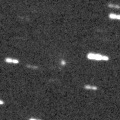
|
Now it is bright as 15.1 mag (Nov. 21, Artyom Novichonok). It stays 14 mag for a long time in 2019. In the Southern Hemisphere, it is observable in excellent condition. In the Northern Hemisphere, it is observable in low sky until early January, but it will be unobservable after that.
Date(TT) R.A. (2000) Decl. Delta r Elong. m1 Best Time(A, h)
Dec. 15 11 30.39 -34 52.1 3.633 3.536 76 15.4 2:53 (284, 53)
Dec. 22 11 30.08 -37 22.8 3.514 3.505 81 15.3 2:55 (286, 59)
|

|
Now it is 15.2 mag (Dec. 10, Toshihiko Ikemura, Hirohisa Sato). It stays 15 mag until March. It is observable in excellent condition in the Northern Hemisphere. It is not observable at all in the Southern Hemisphere.
Date(TT) R.A. (2000) Decl. Delta r Elong. m1 Best Time(A, h)
Dec. 15 11 3.98 61 2.0 2.775 3.288 113 15.4 2:53 (198,-11)
Dec. 22 10 50.15 64 51.8 2.699 3.283 118 15.3 2:55 (192,-12)
|

|
Now it is 15.0 mag (Dec. 5, Sandor Szabo). It is expected to brighten up to 7-8 mag in 2020. In 2018, it will be observable at 15-16 mag in good condition from autum to winter.
Date(TT) R.A. (2000) Decl. Delta r Elong. m1 Best Time(A, h)
Dec. 15 3 15.71 -5 18.0 5.048 5.805 136 15.7 21:39 (180, 60)
Dec. 22 3 11.68 -4 54.9 5.060 5.745 130 15.6 21:08 (180, 60)
|
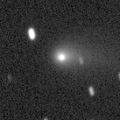
|
Now it is 14.6 mag (Dec. 5, Sandor Szabo). It will be fading after this. It stays observable in excellent condition for a while in the Southern Hemisphere. It locates somewhat low in the Northern Hemisphere.
Date(TT) R.A. (2000) Decl. Delta r Elong. m1 Best Time(A, h)
Dec. 15 23 36.78 -16 43.8 2.078 2.226 85 15.8 20:56 (104, 47)
Dec. 22 23 46.94 -15 9.9 2.177 2.249 81 16.0 21:01 (102, 42)
|

|
It approached to Earth down to 0.3 a.u., and brightened up to 8.3 mag in July (July 22, Juan Jose Gonzalez). Now it is fading. It has faded down to 13.2 mag in September (Sept. 24, Thomas Lehmann). Appearing in the morning sky in the Northern Hemisphere. It will appear in the morning sky in January also in the Southern Hemisphere.
Date(TT) R.A. (2000) Decl. Delta r Elong. m1 Best Time(A, h)
Dec. 15 15 27.71 -3 18.7 3.038 2.305 35 16.0 2:53 (282,-11)
Dec. 22 15 28.53 -2 37.4 3.018 2.379 41 16.2 2:55 (277, -5)
|
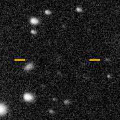
|
Now it is 17.4 mag (Dec. 10, Toshihiko Ikemura, Hirohisa Sato). It was predicted to be observable at 16.5 mag in good condition from autumn to winter. But recently, it is a bit fainter than predicted actually. It locates somewhat low in the Southern Hemisphere.
Date(TT) R.A. (2000) Decl. Delta r Elong. m1 Best Time(A, h)
Dec. 15 8 36.44 24 21.6 1.641 2.456 137 16.4 2:53 (183, 31)
Dec. 22 8 34.23 24 9.5 1.602 2.471 144 16.4 2:34 (180, 31)
|
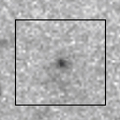
|
Now it is 16.7 mag (Nov. 29, Toshihiko Ikemura, Hirohisa Sato). It is observable at 16.5 mag in good condition in winter.
Date(TT) R.A. (2000) Decl. Delta r Elong. m1 Best Time(A, h)
Dec. 15 4 33.27 0 14.3 0.858 1.793 153 16.5 22:57 (180, 55)
Dec. 22 4 27.84 2 54.8 0.864 1.784 149 16.5 22:24 (180, 52)
|
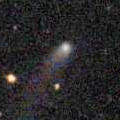
|
It brightened up to 14.7 mag in early 2018 (Jan. 25, Catalina Sky Survey). Now it is fading slowly. Now it is 16.4 mag (Dec. 10, Toshihiko Ikemura, Hirohisa Sato). In the Northern Hemisphere, it stays observable in good condition for a long time until the comet fades out. It is never observable again in the Southern Hemisphere.
Date(TT) R.A. (2000) Decl. Delta r Elong. m1 Best Time(A, h)
Dec. 15 7 19.54 70 50.2 5.366 6.043 129 16.6 1:49 (180,-16)
Dec. 22 6 59.55 71 49.2 5.378 6.067 130 16.6 1:02 (180,-17)
|

|
Now it is 16.1 mag (Dec. 12, Toshihiko Ikemura, Hirohisa Sato). It stays 16-17 mag for a long time until 2020. It is observable in good condition in the Northern Hemisphere. It is not observable at all in the Southern Hemisphere.
Date(TT) R.A. (2000) Decl. Delta r Elong. m1 Best Time(A, h)
Dec. 15 11 51.52 70 17.0 8.071 8.457 109 16.7 2:53 (197,-21)
Dec. 22 11 55.01 70 46.7 8.031 8.455 112 16.7 2:55 (194,-20)
|

|
Now it is 16.3 mag (Dec. 8, Ken-ichi Kadota). It will be getting higher gradually after this. But it will be fading, and will be fainter than 18 mag in January.
Date(TT) R.A. (2000) Decl. Delta r Elong. m1 Best Time(A, h)
Dec. 15 21 54.32 -18 31.4 1.068 1.057 61 16.7 20:56 ( 86, 28)
Dec. 22 22 32.14 -14 58.4 1.108 1.120 64 17.4 21:01 ( 90, 27)
|
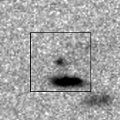
|
Now it is 17.3 mag (Dec. 10, Toshihiko Ikemura, Hirohisa Sato). It is observable at 17 mag in good condition in winter. It locates low in the Southern Hemisphere.
Date(TT) R.A. (2000) Decl. Delta r Elong. m1 Best Time(A, h)
Dec. 15 11 11.94 21 12.9 2.054 2.451 101 17.0 2:53 (222, 21)
Dec. 22 11 16.35 21 52.5 2.008 2.492 107 17.0 2:55 (216, 24)
|

|
It brightened up to 7 mag from May to June in 2017. Now it is fading. It has already faded down to 16.0 mag (Sept. 30, J. Drummond). In the Southern Hemisphere, it stays observable for a long time after this. It will never be observable again in the Northern Hemisphere.
Date(TT) R.A. (2000) Decl. Delta r Elong. m1 Best Time(A, h)
Dec. 15 0 50.29 -48 34.4 6.176 6.173 85 17.1 20:56 ( 47, 67)
Dec. 22 0 50.37 -47 32.5 6.309 6.232 81 17.2 21:01 ( 53, 62)
|

|
Now it is 16.0 mag (Dec. 10, Toshihiko Ikemura, Hirohisa Sato). It was observed at 18 mag in last winter. It will be observable in good condition at 16-17 mag also in this winter.
Date(TT) R.A. (2000) Decl. Delta r Elong. m1 Best Time(A, h)
Dec. 15 7 21.84 2 33.5 2.131 2.995 145 17.2 1:49 (180, 52)
Dec. 22 7 17.96 2 17.4 2.111 3.012 151 17.2 1:18 (180, 53)
|

|
Now it is 17.2 mag (Dec. 12, Toshihiko Ikemura, Hirohisa Sato). Fading slowly. It stays observable at 17 mag in good condition until summer in 2019.
Date(TT) R.A. (2000) Decl. Delta r Elong. m1 Best Time(A, h)
Dec. 15 11 40.95 5 44.2 9.855 9.892 89 17.2 2:53 (239, 29)
Dec. 22 11 42.10 5 49.1 9.748 9.903 96 17.2 2:55 (232, 34)
|
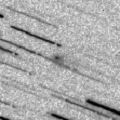
|
First return of a new periodic comet which brightened up to 17.5 mag in 2010. Now it is 17.0 mag (Nov. 29, Toshihiko Ikemura, Hirohisa Sato). It will be fading after this, and will be fainter than 18 mag in late January. It is observable in excellent condition in the Northern Hemisphere. It locates low in the Southern Hemisphere.
Date(TT) R.A. (2000) Decl. Delta r Elong. m1 Best Time(A, h)
Dec. 15 6 2.83 36 4.6 1.067 2.034 165 17.2 0:31 (180, 19)
Dec. 22 5 57.33 36 45.7 1.082 2.052 166 17.3 23:53 (180, 18)
|
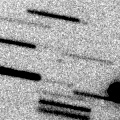
|
Now it is 17.9 mag (Dec. 10, Toshihiko Ikemura, Hirohisa Sato). It is observable at 17 mag in good condition in winter in the Northern Hemisphere. It locates very low in the Southern Hemisphere.
Date(TT) R.A. (2000) Decl. Delta r Elong. m1 Best Time(A, h)
Dec. 15 10 30.11 32 51.6 0.795 1.496 114 17.4 2:53 (207, 16)
Dec. 22 10 46.20 33 33.2 0.774 1.505 117 17.3 2:55 (204, 17)
|

|
Now it is 17.2 mag (Nov. 30, Toshihiko Ikemura, Hirohisa Sato). It will be fading gradually after this, and it will be fainter than 18 mag in winter. In the Northern Hemisphere, it stays observable in good condition for a long time. In the Southern Hemisphere, it will never be observable again.
Date(TT) R.A. (2000) Decl. Delta r Elong. m1 Best Time(A, h)
Dec. 15 22 59.00 67 32.6 7.590 7.960 108 17.4 20:56 (161,-20)
Dec. 22 23 5.14 66 38.7 7.656 7.988 106 17.4 21:01 (158,-21)
|

|
Now it is 17.2 mag (Nov. 29, Toshihiko Ikemura, Hirohisa Sato). It was observed at 17 mag in last winter. It will be observable in good condition at 17.5 mag also in this winter.
Date(TT) R.A. (2000) Decl. Delta r Elong. m1 Best Time(A, h)
Dec. 15 4 57.59 5 16.2 7.116 8.051 160 17.4 23:21 (180, 50)
Dec. 22 4 52.16 4 57.8 7.153 8.058 155 17.4 22:48 (180, 50)
|
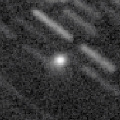
|
Now it is 18.7 mag (Dec. 14, Toshihiko Ikemura, Hirohisa Sato). It brightened up to 16 mag in 2018 spring. It stays observable in good condition until 2019 spring when the comet will be fainter than 18 mag. It is fainter than this ephemeris recently.
Date(TT) R.A. (2000) Decl. Delta r Elong. m1 Best Time(A, h)
Dec. 15 10 56.28 7 16.1 3.305 3.611 100 17.5 2:53 (228, 35)
Dec. 22 10 57.06 8 36.3 3.235 3.654 107 17.5 2:55 (219, 38)
|
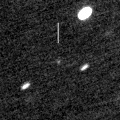
|
Now it is 17.2 mag (Nov. 29, Toshihiko Ikemura, Hirohisa Sato). It is observable at 17.5 mag until January, in good condition in the Northern Hemisphere. It locates very low in the Southern Hemisphere.
Date(TT) R.A. (2000) Decl. Delta r Elong. m1 Best Time(A, h)
Dec. 15 6 20.04 42 26.3 2.869 3.800 157 17.6 0:48 (180, 13)
Dec. 22 6 14.21 42 59.1 2.871 3.811 160 17.6 0:15 (180, 12)
|

|
Now it is 17.8 mag (Dec. 14, Toshihiko Ikemura, Hirohisa Sato). It is observable at 17.5 mag in excellent condition in January.
Date(TT) R.A. (2000) Decl. Delta r Elong. m1 Best Time(A, h)
Dec. 15 8 11.27 9 49.6 0.801 1.673 138 17.8 2:38 (180, 45)
Dec. 22 8 13.98 7 35.9 0.762 1.662 144 17.6 2:14 (180, 47)
|

|
It was expected to be observable at 17.5 mag in good condition in winter in the Northern Hemisphere. But actually, it is so faint as 21.0 mag (Oct. 5, K. Sarneczky, et. al). It locates low in the Southern Hemisphere.
Date(TT) R.A. (2000) Decl. Delta r Elong. m1 Best Time(A, h)
Dec. 15 5 36.65 33 42.8 2.081 3.053 169 17.7 0:05 (180, 21)
Dec. 22 5 30.52 34 7.7 2.077 3.045 167 17.7 23:26 (180, 21)
|

|
First return of a new periodic comet discovered in 2014. It has not been recovered yet. Now it is not detected, fainter than 20.0 mag (Dec. 10, Toshihiko Ikemura, Hirohisa Sato). The condition of this apparition is excelllent. It will brighten rapidly, and will be observable at 15.5 mag in excellent condition in March.
Date(TT) R.A. (2000) Decl. Delta r Elong. m1 Best Time(A, h)
Dec. 15 10 56.73 4 42.0 1.559 1.970 99 17.9 2:53 (229, 37)
Dec. 22 11 7.09 3 40.6 1.461 1.941 103 17.7 2:55 (225, 41)
|
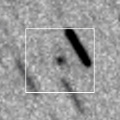
|
Now it is 17.7 mag (Dec. 8, Toshihiko Ikemura, Hirohisa Sato). First return of a new periodic comet which brightened up to 16 mag in 2011. It is observable at 17.5 mag in good condition in winter.
Date(TT) R.A. (2000) Decl. Delta r Elong. m1 Best Time(A, h)
Dec. 15 2 35.96 13 31.8 1.627 2.450 138 17.7 21:00 (180, 41)
Dec. 22 2 35.79 12 49.5 1.675 2.434 130 17.7 21:01 (171, 42)
|
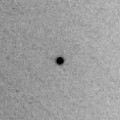
|
Now it is 17.0 mag (Nov. 27, MASTER-II Observatory, Tunka). It will be fading after this, and will be fainter than 18 mag in December. It is observable in good condition in the Northern Hemisphere. It is not observable in the Southern Hemisphere. Its cometary activity was observed on Mar. 26 (M. Mommert, D. Polishook, N. Moskovitz).
Date(TT) R.A. (2000) Decl. Delta r Elong. m1 Best Time(A, h)
Dec. 15 0 55.73 47 36.3 2.104 2.749 121 17.7 20:56 (164, 5)
Dec. 22 0 58.30 46 38.9 2.221 2.805 116 17.9 21:01 (159, 4)
|
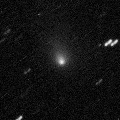
|
It brightened very rapidly up to 13.8 mag in August in 2017 (Aug. 22, Kunihiro Shima). Although it was faint as 16-17 mag in November, it brightened up to 14.7 mag in December (Dec. 12, Toshihiko Ikemura, Hirohisa Sato). In the Northern Hemisphere, it stays observable in excellent condition after this. It stays extremely low in the Southern Hemisphere.
Date(TT) R.A. (2000) Decl. Delta r Elong. m1 Best Time(A, h)
Dec. 15 11 14.00 31 50.7 2.239 2.667 104 17.8 2:53 (216, 13)
Dec. 22 11 19.16 32 47.0 2.190 2.696 110 17.8 2:55 (211, 14)
|

|
It is expected to brighten up to 10 mag in autumn in 2019. Now it is 17.4 mag (Dec. 10, Toshihiko Ikemura, Hirohisa Sato). In the Northern Hemisphere, it stays observable for a long time while the comet is brightening. In the Southern Hemisphere, it it not observable until late September in 2019.
Date(TT) R.A. (2000) Decl. Delta r Elong. m1 Best Time(A, h)
Dec. 15 13 19.60 48 26.4 3.564 3.707 90 18.0 2:53 (221,-16)
Dec. 22 13 27.81 50 33.4 3.420 3.640 95 17.8 2:55 (218,-14)
|
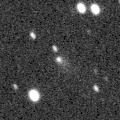
|
First return of a new periodic comet which brightened up to 16.5 mag in 2005. Now it is 17.8 mag (Dec. 14, Toshihiko Ikemura, Hirohisa Sato). It will be fading after this, and will be fainter than 18 mag in December. It locates low in the Southern Hemisphere.
Date(TT) R.A. (2000) Decl. Delta r Elong. m1 Best Time(A, h)
Dec. 15 1 58.02 22 28.5 1.459 2.239 131 17.8 20:56 (171, 32)
Dec. 22 2 3.36 21 30.2 1.543 2.264 125 18.0 21:01 (163, 32)
|
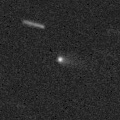
|
It brightened rapidly. Now it is 17.5 mag (Nov. 30, Toshihiko Ikemura, Hirohisa Sato). It will be fading after this, and will be fainter than 18 mag in December.
Date(TT) R.A. (2000) Decl. Delta r Elong. m1 Best Time(A, h)
Dec. 15 1 41.50 2 50.7 1.902 2.559 121 17.9 20:56 (160, 50)
Dec. 22 1 43.67 3 37.5 1.992 2.572 115 18.1 21:01 (150, 47)
|
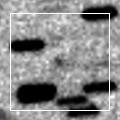
|
Now it is 18.8 mag (Nov. 29, Toshihiko Ikemura, Hirohisa Sato). It is observable at 18 mag in winter.
Date(TT) R.A. (2000) Decl. Delta r Elong. m1 Best Time(A, h)
Dec. 15 7 2.89 20 59.6 2.590 3.522 157 18.0 1:31 (180, 34)
Dec. 22 6 58.44 21 12.0 2.553 3.516 166 17.9 0:59 (180, 34)
|
|
![]()
 C/2015 O1 ( PanSTARRS )
C/2015 O1 ( PanSTARRS ) 123P/West-Hartley
123P/West-Hartley C/2017 B3 ( LINEAR )
C/2017 B3 ( LINEAR ) C/2018 A6 ( Gibbs )
C/2018 A6 ( Gibbs ) C/2018 A3 ( ATLAS )
C/2018 A3 ( ATLAS ) C/2017 T2 ( PanSTARRS )
C/2017 T2 ( PanSTARRS ) 48P/Johnson
48P/Johnson C/2018 N1 ( NEOWISE )
C/2018 N1 ( NEOWISE ) 59P/Kearns-Kwee
59P/Kearns-Kwee 171P/Spahr
171P/Spahr C/2016 A1 ( PanSTARRS )
C/2016 A1 ( PanSTARRS ) C/2010 U3 ( Boattini )
C/2010 U3 ( Boattini ) 300P/Catalina
300P/Catalina 164P/Christensen
164P/Christensen C/2015 V2 ( Johnson )
C/2015 V2 ( Johnson ) 361P/2017 S4 ( Spacewatch )
361P/2017 S4 ( Spacewatch ) C/2014 B1 ( Schwartz )
C/2014 B1 ( Schwartz ) 369P/2018 P1 ( Hill )
369P/2018 P1 ( Hill ) 247P/LINEAR
247P/LINEAR C/2014 OE4 ( PanSTARRS )
C/2014 OE4 ( PanSTARRS ) C/2015 XY1 ( Lemmon )
C/2015 XY1 ( Lemmon ) C/2018 E1 ( ATLAS )
C/2018 E1 ( ATLAS ) 159P/LONEOS
159P/LONEOS 239P/LINEAR
239P/LINEAR 232P/Hill
232P/Hill P/2014 C1 ( TOTAS )
P/2014 C1 ( TOTAS ) 373P/2018 R2 ( Rinner )
373P/2018 R2 ( Rinner ) (3552) Don Quixote
(3552) Don Quixote 240P/NEAT
240P/NEAT C/2018 W2 ( Africano )
C/2018 W2 ( Africano ) 368P/2018 L3 ( NEAT )
368P/2018 L3 ( NEAT ) 243P/NEAT
243P/NEAT 31P/Schwassmann-Wachmann 2
31P/Schwassmann-Wachmann 2![]()









































